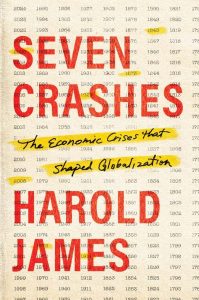In Seven Crashes: The Economic Crises that Shaped Globalization, Harold James explores major market crashes from the last 170 years, examining their causes (whether they were demand or supply crashes) and their impacts on globalisation. In Kyle Scott‘s view, the book shares valuable, engaging analysis of these economic crises, though its apparent aim to appeal to both general and specialist audiences falls somewhat short.
Seven Crashes: The Economic Crises that Shaped Globalization. Harold James. Yale University Press. 2023.
 In the wake of the predicted financial crash of 2022 that never was, commentators are scratching their heads as to why it hasn’t happened. There has been inflation, rising interest rates and job loss, but economies have continued to grow and recession in most countries has been averted. It seems economists, and economic prognosticators, are not great at predicting events. Following the 2008 market crash, there were a few people positioned to profit from the collapse, but that there were not more economists shorting the housing market and financial institutions seems to be good evidence of their limited forecasting capabilities.
In the wake of the predicted financial crash of 2022 that never was, commentators are scratching their heads as to why it hasn’t happened. There has been inflation, rising interest rates and job loss, but economies have continued to grow and recession in most countries has been averted. It seems economists, and economic prognosticators, are not great at predicting events. Following the 2008 market crash, there were a few people positioned to profit from the collapse, but that there were not more economists shorting the housing market and financial institutions seems to be good evidence of their limited forecasting capabilities.
But economists can look back and teach us what lessons we should have learned. In Seven Crashes: The Seven Crises that Shaped Globalization, Harold James looks at seven market crashes and tries to draw a few important lessons for readers. How successful this historical look will be at informing our understanding of the future is unknown.
James divides crashes into “good” and “bad, defining as good those that lead to increased globalisation and prosperity and bad those that lead to markets contracting or turning inward.
James, the Claude and Lore Kelly Professor of European Studies at Princeton University, has spent a career studying economic history. He is a prolific author who is also the official historian of the International Monetary Fund. James divides crashes into “good” and “bad”, defining as good those that lead to increased globalisation and prosperity and bad those that lead to markets contracting or turning inward.
In reading his accounts of each of these crashes, there were events that occurred in foreign markets that led to crashes in domestic markets. There were also close linkages between private financiers and governments that eventually soured when the financier’s business interests unravelled and caused harm to the government’s finances and citizens.
For instance, Ivar Kreuger, an account of whom is provided in chapter four, founded the Swedish Match Company in 1907. In his attempt to gain a worldwide monopoly on matches, he would lend money to governments in exchange for his company to have exclusive access to their markets. Kreuger raised capital in the US to buy undervalued assets in Central Europe to expand his match manufacturing and distribution empire during the mid-1920s. He lent money to France, Greece, Ecuador, Latvia, Estonia, Yugoslavia, Hungary, Bolivia, Guatemala, Poland, Turkey, and Romania. In order to expand this scheme to Germany, and gain control of the German match market, he raised capital in the US through complex debt instruments. His timing could not have been worse, as the scheme was executed in October of 1929. The Kreuger empire crumbled – in part because of the market crash and in part because of his fraudulent accounting practices – and the effects reverberated in countries that relied on his money and his counsel.
In James’s telling, the Great Depression led to deglobalisation even after World War Two
In James’s telling, the Great Depression led to deglobalisation even after World War Two for several reasons. First, technology, particularly in America, increased production in a way that made international trade less important than domestic consumption. Second, World War Two ignited the domestic production engine of many countries as global trade was limited during the war while demand was high. Third, governments enacted protectionists policies such as tariffs that made foreign goods less competitive and emigration restrictions that insulated domestic workers from competition which drove up wages.
As a result [of the economic crash in the 1840s] business leaders and governments recognised that globalisation was necessary to build interconnected economies resistant to resist supply shocks.
The Great Depression was caused by a demand shock, whereas the crash in the 1840s was precipitated by a supply shock. In Chapter One, James demonstrates that the crash of the 1840s in Europe was caused by “famine, malnutrition, disease, and revolt” (26). As a result, business leaders and governments recognised that globalisation was necessary to build interconnected economies resistant to resist supply shocks. Central banks and financiers gained more influence during this period as new sources of capital were needed to finance new projects. Governments incentivised domestic production as well as trade with foreign markets. The eventual effect of this interconnectedness was a deflationary effect on prices coupled with new financial instruments developed to finance large infrastructure projects like railroads. The new financial schemes enabled greater accumulation of capital by financiers and titans of industry. Exuberance preceded – as it had in the 1920s – the crash of the 1870s. The accumulation of capital and globalisation meant the crash was widespread. This begs a question that James does not answer. Why is globalisation good if it can result in contagion which makes the effects of crashes deeper and more widespread? It would be helpful for the reader to understand how James would address this.
Why is globalisation good if it can result in contagion which makes the effects of crashes deeper and more widespread?
The book seems to be written for two audiences, which might leave both unsatisfied. It appears to be written for a general audience, but the anecdotes seem to be drawn haphazardly and there is not an obvious outline that would make it easy for the general reader to draw parallels between chapters. The chapter titles themselves do not offer much help in terms of a timeline, as the names are only useful for those already familiar with economic history and the phrases used to describe the various crashes. For instance, chapter 2 is titled “Krach at the Margins.” Most readers will not know he’s referencing when “krach” was first used to describe a financial crisis in 1873. The introduction lacks a list of the seven crashes that the book is about to tackle. An academic audience, who will be more comfortable with some of the references, will be underwhelmed by the rigor of the research. What general readers will enjoy, however, are the biographies of influential economists during each of the crashes and how their views were either reflective of, or influenced, the decisions of policy makers and business leaders. James acknowledges that their effect is limited, but it opens a set of interesting questions about where economic ideas come from and how they disseminate. His treatment of economists such as Karl Marx, John Maynard Keynes, and Friedrich Hayek is interesting and illuminating.
[The book] sheds light on our most recent period of economic uncertainty and provides an interesting view of crashes by defining them as either demand crashes or supply crashes.
Those qualms aside, this book is an easy and informative read. It sheds light on our most recent period of economic uncertainty and provides an interesting view of crashes by defining them as either demand crashes or supply crashes. Readers who want to know more about the differences and similarities between crashes, the ramifications of each, and what effect the COVID-19 lockdowns had on international economic development will enjoy this book. Adding prominent economic thinkers into the mix provides a refreshing reprieve from the recounting of events. James does a great job showing the extent and limitations of economists on the thinking of the time. The biographical accounts of economists, and their role in practical affairs, is a unique feature of this book that distinguishes it from other books in the field which makes it well worth the read. This alone makes the book worth a read even if one does walk away paraphrasing Anna Karenina: “Prosperous times are all alike; every market crash happens for its own reasons.”
This post gives the views of the author, and not the position of the LSE Review of Books blog, or of the London School of Economics and Political Science. The LSE RB blog may receive a small commission if you choose to make a purchase through the above Amazon affiliate link. This is entirely independent of the coverage of the book on LSE Review of Books.
Image Credit: Everett Collection on Shutterstock.







